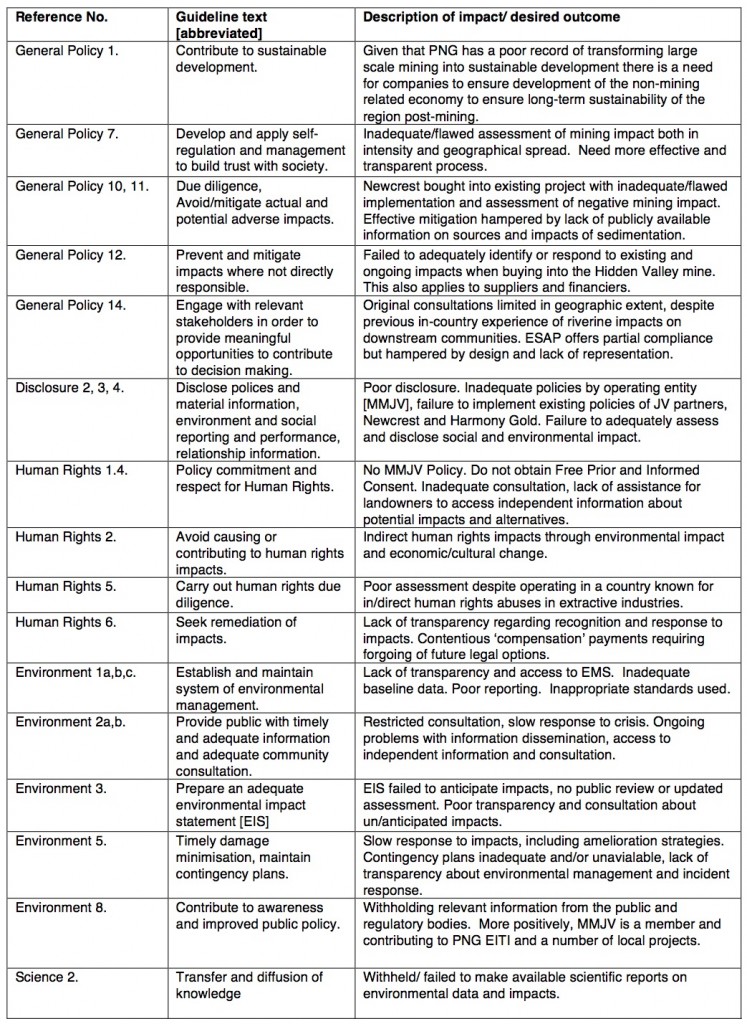Watut River – Newcrest Mining Sustainability Report 2014
Newcrest Mining released their 2014 Sustainability Report earlier in April. As a large Australian gold mining company, Newcrest operate a number of mining and exploration sites in Australia, Africa, Asia and the Pacific. These include both the Hidden Valley mine and Wafi-Golpu exploration/development site in the Morobe Province of Papua New Guinea, which are operated with Harmony Gold.
The Mineral Policy Institute (MPI) is a little skeptical of the value of sustainability reports, as they are often a defense of the status quo rather than a tool for improvement. A typical report makes the company sound responsible, but omits any real challenges and uncomfortable truths. Hoping for change, from the company that wants to be seen as the ‘miner of choice’ MPI had a look.
Important background is that in October 2014 at Newcrest’s AGM, MPI formally presented copies of the Hidden Valley documentary and the accompanying report Mining in Morobe, Papua New Guinea: Impacts from mining along the Watut River to Newcrest Board Chair Peter Hay and CEO Sandeep Biswas. Hidden Valley contained strong feedback from communities about the need to change the approach to mining development, giving communities the right to ‘choose their own future’. The Mining in Morobe Report supported this with an assessment and analysis of Newcrest and Harmony Gold’s reporting. Multiple breaches were found in convention of the ICMM Principles, the OCED Guidelines and the Equator Principles with further problems relating to company policies, sustainability reporting and assurance.
We are pleased to acknowledge once again that Newcrest became a member of the Extractive Industries Transparency Initiative (EITI) and the Voluntary Principles on Security and Human Rights during 2014. Both provide opportunities for Newcrest to improve their performance and set a good example for other companies.
We note that Newcrest gave their own work a tick of approval in relation to stakeholder engagement and the International Council of Metals and Mining (ICMM) and Global Reporting Index (GRI) Principles. Unfortunately they never mentioned the Watut River, let alone the ongoing impacts on community and environment caused by sedimentation from the Hidden Valley mine.
It is useful to compare that self-assessment with the number of (unacknowledged in the report) sustainability issues at Hidden Valley and Wafi-Golpu. Table 1, from the Mining in Morobe Report assesses Newcrest and Harmony’s (and the Morobe Mining Joint Venture, MMJV) activities against a number of OECD Guidelines finding numerous breaches. MPI is yet to receive a response to these specific findings or a general response to Hidden Valley and Mining in Morobe Report.
Interestingly, despite being employed by Newcrest and guided by their criteria, the assurer, Ernst and Young made a number of interesting statements (p.52) alongside their limited assurance statement. In brief these included: (1) the benefits from strengthening engagement with NGO’s at a corporate level; (2) additional direct engagement with external stakeholders regarding reporting criteria; (3) additional case studies of interest to specific interest groups to demonstrate Newcrest’s response to challenges (ie Watut River); (4) improving the timeliness of the report as a means of identifying onsite issues and responding to stakeholder interests.
Despite having fundamental concerns about sustainability reporting and largely obscure assurance assessments, MPI supports these observations by Ernst and Young. While not addressing the fundamental power inequality between community and company, or the reducing the impacts on people and place, the recommendations could, if adopted by Newcrest, at least result in some improvements in reporting and acknowledgement of stakeholders concerns.
Table 1. Assessment of MMJV:Newcrest Activities against OCED Guidelines 